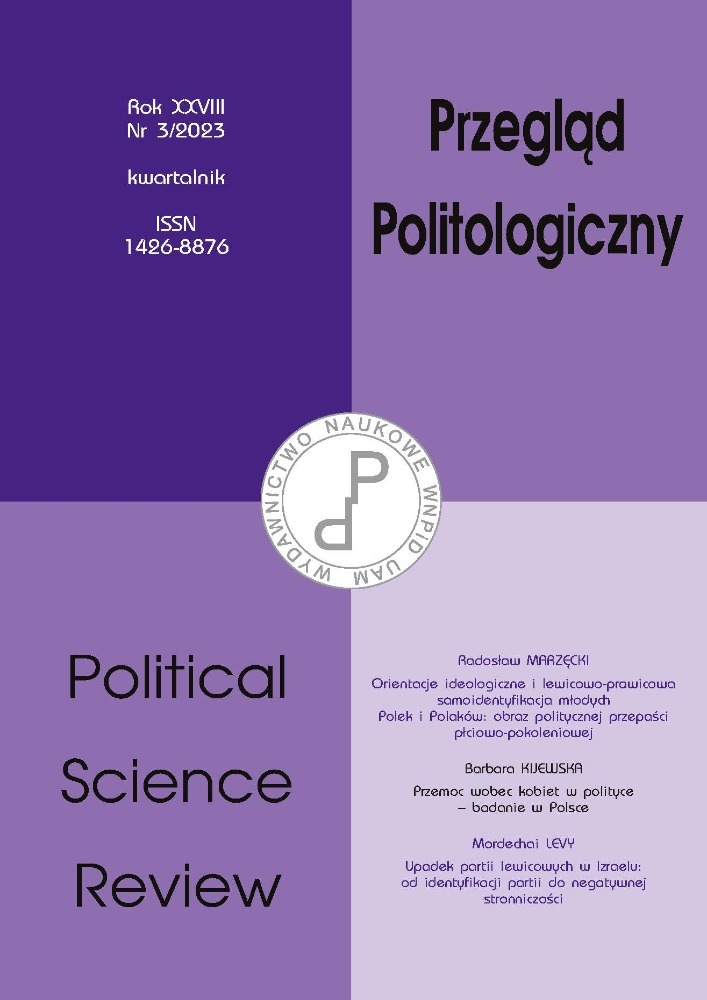Abstrakt
Wizerunek miasta jest produktem ostatecznym i kształtuje się w toku działań mających charakter procesowy. Miasto, pragnące osiągnąć sukces rynkowy, powinno dążyć do kształtowania pozytywnego wizerunku. W tym aspekcie konieczne jest regularne badanie wizerunku postrzeganego miasta. Zasadniczą rolę odgrywa tu tożsamość i marka miasta. Celem artykułu jest identyfikacja wizerunku Warszawy promowanego przez władze lokalne oraz postrzeganego wizerunku miasta wśród jej mieszkańców. Potwierdzona została teza, że nie ma pełnej zgodności pomiędzy wizerunkiem Warszawy promowanym przez władze lokalne a wizerunkiem miasta w świadomości jego mieszkańców. Artykuł składa się z trzech części. W pierwszej omówiono pojęcia tożsamości, marki i wizerunku miasta. Druga charakteryzuje markę m.st. Warszawy i jej elementy składowe. W trzeciej zaś przedstawiono postrzegany wizerunek miasta stołecznego Warszawy. W artykule wykorzystano następujące metody badawcze: analiza literatury, analiza dokumentacji wewnętrznej Urzędu m.st. Warszawy w postaci raportów i raportów w obszarze zagadnień wizerunkowych. Ponadto analizie poddano dokumenty źródłowe w postaci strategii rozwoju miasta, dotyczących zagadnień promocyjnych i wizerunkowych miast w wymiarze krajowym i międzynarodowym. Zastosowano również metodę dedukcji. Przeprowadzone rozważania pozwoliły na pozytywną weryfikację tezy. Ponadto pokazały, że pozytywny wizerunek miasta jest istotnym czynnikiem jego rozwoju.
Bibliografia
Altkorn J. (2002), Kształtowanie rynkowego wizerunku firmy, Wydawnictwo Akademii Ekonomicznej w Krakowie, Kraków.
Badanie tożsamości Warszawy i jej mieszkańców, https://um.warszawa.pl/documents/39703/7003459/tozsamosc_warszawy_mieszkancy_raport_0.pdf/643e14bf-7cd7-e412-a46d-18609699bce8?t=1634498849984, 27.07.2023.
Baker B. (2011), Foreword, in: City Brandinf. Theory and Cases, ed. K. Dinnie, Palgrave Macmillan, Basingstoke.
Boisen M., Terlouwb K., Grootea P., Couwenberga O. (2018), Reframing place promotion, place marketing nad place branding – moving boyed conceptual confusion, “Cities”, vol. 80. DOI: https://doi.org/10.1016/j.cities.2017.08.021
Brandys J. (2009), Znaczenie marki miasta w kreowaniu i komunikowaniu wartości dla klienta, Zeszyty Naukowe Uniwersytetu Ekonomicznego w Poznaniu, no. 129.
Co piszą o Warszawie media? Co mówią o niej użytkownicy social mediów? Podsumowanie analizy wizerunku i narracji o Warszawie w mediach i mediach społecznościowych (2023), Warszawa, https://um.warszawa.pl/documents/62144/66515376/Analiza+narracji_podsumowanie.pdf/6428ab86-e395-be0e-5e3c-deb5758546ab?t=1677832995685, 25.07.2023.
Florek M. (2013), Podstawy marketingu terytorialnego, Wydawnictwo Uniwersytetu Ekonomicznego w Poznaniu, Poznań.
Florek M., Glińska E., Kowalewska A. (2009), Wizerunek miasta od koncepcji do wdrożenia, Woltres Kluwer, Warszawa.
Glińska E. (2016), Budowanie marki miasta, Wolters Kluwer SA, Kraków.
Govers R. (2009), Go, Place Branding: Glocal, Virtual and Physical Identities, Imagined and experienced, Palgrave Macmilan, New York. DOI: https://doi.org/10.1007/978-0-230-24702-4
Hereźniak M. (2020), Marka miasta – między teorią a praktyką, in: Strategie budowania marki i rozwoju handlu. Nowe trendy i wyzwania dla marketingu, ed. T. Domański, Uniwersytet Łódzki, Polskie Wydawnictwo Ekonomiczne S.A., Łódź–Warszawa. DOI: https://doi.org/10.18778/8142-903-0.04
Hudson S., Cardenas D., Meng F., Thal K. (2016), Bulding a place brand frm the battom up: A case study from the United States, “Journa of Vacation Marketing”, no. 23(4). DOI: https://doi.org/10.1177/1356766716649228
Jain D. C., Maesincee S., Kotler Ph. (2002), Marketing nie stoi w miejscu, Agencja Wydawnicza Placet, Warszawa.
Korzyńska K. (2013), Zarządzanie marką miasta, siła marki, „Finanse, Rynki Finansowe, Ubezpieczenia. Zeszyty Naukowe Uniwersytetu Szczecińskiego”, no. 64/2.
Kotler Ph., Keller K. L. (2022), Marketing, Rebis, Warszawa.
Krall J. (2002), 13 zasad zarządzania marką, „Marketing w Praktyce”, no. 2.
Marka Warszawa. Praktyczny przewodnik (2018), https://um.warszawa.pl/documents/62144/7000640/master.pdf/12595d0c-97f7-4e33-d2aa-32ef371d6df3?t=1634499006520, 15.07.2023.
Marushchak V. (2020), Doświadczenia przeszłości a współczesny wizerunek marki Nowego Jorku i Singapuru. Analiza porównawcza, “Ur journal of Humanities and Social Sciences”, no. 4(17). DOI: https://doi.org/10.15584/johass.2020.4.9
Nawrocka E. (2009), Wizerunek miejsca recepcji turystycznej w perspektywie ekonomicznej (nowe podejście), Prace Naukowe nr 46 Uniwersytetu Ekonomicznego we Wrocławiu, Wrocław.
Odkrywaj Warszawę, https://wot.waw.pl/, 1.08.2023.
Raftowicz-Filipkiewicz M. (2013), Marketing terytorialny jako narzędzie budowania przewagi konkurencyjnej gmin Doliny Baryczy, „Nauki o Zarządzaniu. Management Sciences”, no. 1(13).
Raport z badania ilościowego na temat wizerunku Warszawy wśród mieszkańców wybranych krajów europejskich (2019), Warszawa, https://wot.waw.pl/wp-content/uploads/2017/04/POPRAWIONY_Raport_z_badania_wizerunku_Warszawy_wsrod_mieszkancow_krajow_europejskich_2016.pdf.
Stanowicka-Traczyk A. (2008), Kształtowanie wizerunku miasta na przykładzie miast polskich, Oficyna Wydawnicza Branta, Olsztyn.
Strategia #Warszawa 2030 (2018), https://wot.waw.pl/wp-content/uploads/2019/04/Strategia-Warszawa2030.pdf, 22.07.2023.
Szlis I. (2020), Wizerunek – jak go zmierzyć i go poprawić, Wyd. 2, CeDeWu, Warszawa.
Szromnik A. (2016), Marketing terytorialny. Miasto i region na rynku, Wolters Kluwer, Kraków.
Szromnik A. (2008), Marketing terytorialny, Wolters Kluwer, Kraków.
Szwajca D. (2009), Jak zmienić wizerunek miasta, „Marketing i Rynek”, no. 2(28).
Temporal P. (2015), Branding for Public Sector, Wiley, Chichester. DOI: https://doi.org/10.1002/9781119176824
Warsaw City Break, https://wot.waw.pl/, 1.08.2023.
Wizerunek Warszawy wśród jej mieszkańców. Raport z badania jakościowego (2022), Warszawa, https://um.warszawa.pl/documents/62144/66515376/Wizerunek_Warszawy_wsrod_jej_mieszkancow_WCAG.pdf/fd4412c9-f177-18b5-d427-bff20d96f367?t=1669812353604, 25.07.2023.
Wytyczne do komikowania marki Warszawa w obszarze turystyki (2018), https://um.warszawa.pl/documents/62144/7000640/Wytyczne_do_komunikowania_marki_Warszawa_wobszarze_turystyki_0.pdf/410003bb-3709-9741-203a-3227d7b02005?t=1634499006547, 17.07.2023.
Zdon-Korzeniowska M. (2012), Budowa marki regionalnej na wybranych przykładach województw, Prace Komisji Geografii Przemysłu, no. 19. DOI: https://doi.org/10.24917/20801653.19.10
Licencja
Prawa autorskie (c) 2023 Anna Śleszyńska-Świderska

Utwór dostępny jest na licencji Creative Commons Uznanie autorstwa – Na tych samych warunkach 4.0 Miedzynarodowe.

